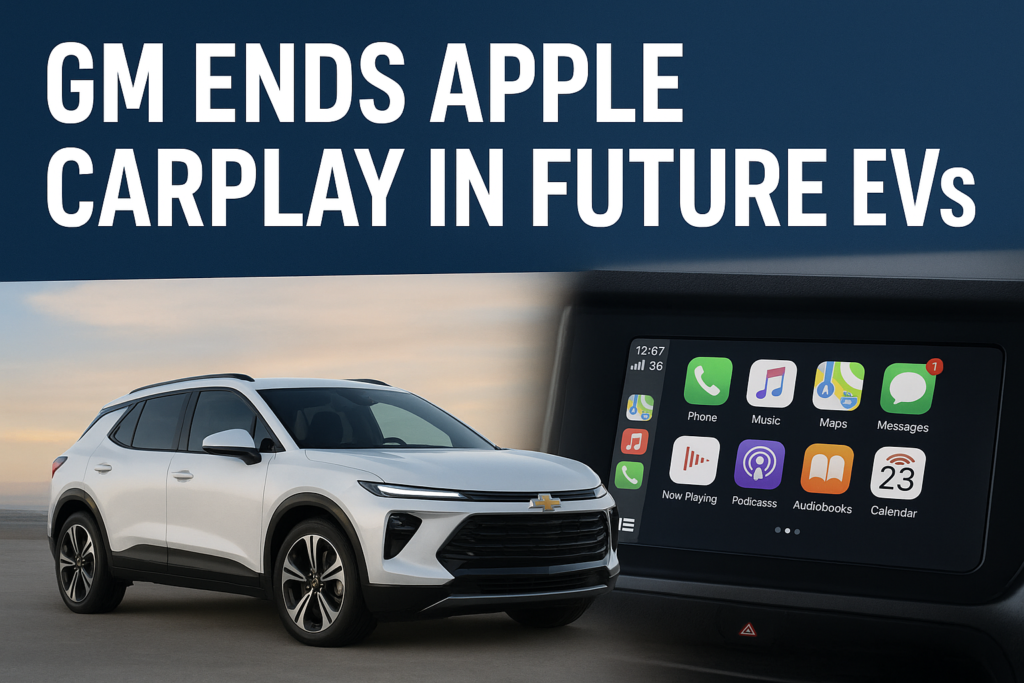General Motors (GM) plans to remove Apple CarPlay from all upcoming electric vehicles (EVs). Instead, it will use a Google-based infotainment system. Here’s why GM is making this bold move — and how it could affect your driving experience.
Table of Contents
Introduction
In a surprising shift, General Motors (GM) has announced that it will no longer offer Apple CarPlay or Android Auto in its upcoming electric vehicles (EVs). Starting with the 2024 Chevrolet Blazer EV, this marks a major change in the way drivers will connect their smartphones with their cars.
Instead of relying on Apple’s popular mirroring system, GM is teaming up with Google to create its own built-in infotainment platform. While GM claims this change is about enhancing integration and future technology, not all drivers are happy about losing one of the most beloved in-car features.
Why GM Is Removing Apple CarPlay
According to GM, this move is not about taking away convenience but about deepening system integration in its electric cars. The automaker believes that future EVs will require closer coordination between the car’s navigation, charging network, and driver assistance systems.
GM’s Executive Director of Digital Cockpit Experience, Mike Hichme, explained that the company wants these features to work independently of smartphones. In other words, GM doesn’t want critical driving or charging features to rely on whether or not your phone is connected.
“We have a lot of new driver assistance features coming that are more tightly coupled with navigation,” Hichme said. “We don’t want to design these features in a way that depend on a person having a cellphone.”
The goal is to make the in-car experience seamless and fully integrated — but this shift means drivers will lose the familiar CarPlay interface they’ve come to love.
What Will Replace CarPlay in GM’s EVs
GM has been developing its own infotainment system in collaboration with Google since 2019. The system will include built-in access to:
- Google Maps
- Google Assistant
- Spotify, Audible, and other apps directly from the car’s screen
Buyers of new GM EVs will also get eight years of free access to Google Maps and Google Assistant, ensuring they don’t need their smartphones for essential features.
GM’s idea is to create a connected environment where the car’s software, navigation, and charging systems work as one. For instance, your GM EV could automatically plan routes with optimal charging stops — something third-party systems like CarPlay can’t fully manage yet.
You can also read: Toyota Land Cruiser FJ 2027: A Retro-Inspired Off-Roader We Might Never Get
The Consumer Backlash
Despite GM’s explanation, many drivers and tech enthusiasts are unhappy. Apple CarPlay and Android Auto are among the most-loved car features, providing a simple way to access music, messages, and navigation without distractions.
Research by AutoPacific shows that wireless Apple CarPlay and Android Auto rank as the second-most desired in-car tech feature for new car buyers. Removing it, especially from high-end EVs, may alienate loyal customers.
Online reactions have been mostly negative, with users expressing frustration that GM is forcing them to use its own ecosystem instead of giving them a choice.

A Question of Data and Control
Another major reason behind this move might be data. When drivers use Apple CarPlay, much of the user data — such as navigation history, locations, and preferences — stays with Apple, not the car manufacturer.
By shifting to a Google-integrated system, GM gains more control and access to valuable user data. This data could help GM improve its services, but it also opens the door to subscription-based features and personalized marketing.
GM’s CEO Mary Barra has already stated that the company expects $20–25 billion in annual revenue from software and subscription services by 2030.
This indicates that GM’s long-term plan is not just about user experience — it’s also about creating new revenue streams in the digital age.
Will CarPlay Remain in Gasoline Vehicles?
For now, GM’s gasoline-powered cars will continue to support Apple CarPlay and Android Auto. The automaker has promised not to remove these systems from existing vehicles that already have them.
However, since GM plans to stop producing internal combustion engine (ICE) vehicles by 2035, this means CarPlay will eventually disappear from all new GM models.
In the meantime, Bluetooth connectivity will still allow drivers to make calls or play music, but the deep integration that CarPlay offered — like navigation and message handling — will be gone.
Is This a Smart Move or a Risky Bet?
GM’s strategy is bold. On one hand, a fully integrated infotainment ecosystem could offer better EV performance, smarter route planning, and advanced safety. Tesla has already proven that a closed ecosystem can work if done right.
On the other hand, Apple CarPlay’s simplicity and familiarity are major selling points for many car buyers. Removing it could push some potential customers toward competitors who continue to offer it — like Ford or Hyundai.
This decision could define how automakers approach software and data ownership in the next decade.
Conclusion
General Motors’ decision to drop Apple CarPlay from its future EV lineup marks a turning point in the automotive industry. It’s a clear signal that carmakers are shifting from being just vehicle manufacturers to becoming tech companies on wheels.
While GM’s move might improve EV integration and long-term innovation, it also raises important questions about user choice, data privacy, and brand loyalty.
Whether this gamble pays off will depend on how well GM’s Google-powered system performs — and whether drivers are willing to trade familiarity for future-forward connectivity.